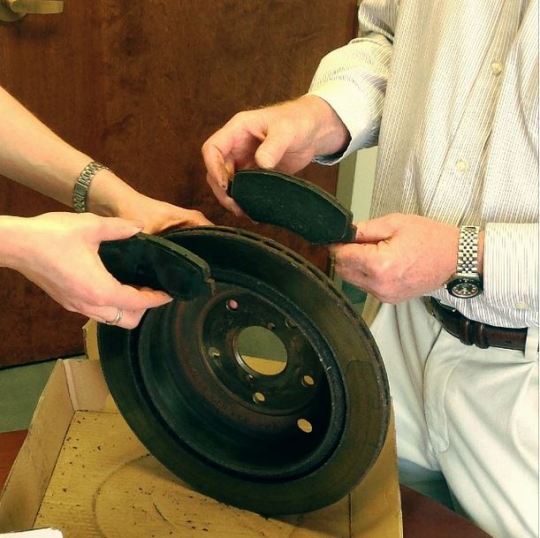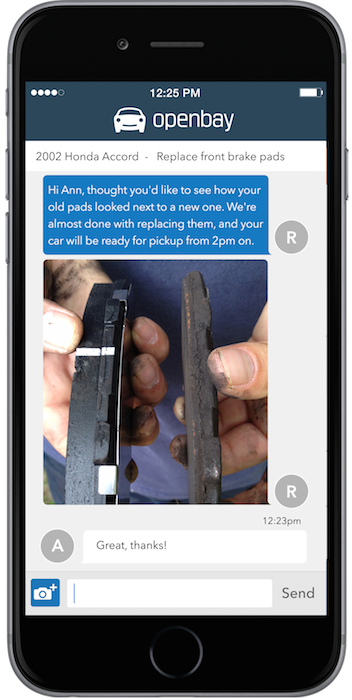Your brakes are one of the least maintenance-intensive and most reliable systems on your vehicle. A normal brake replacement takes only a few minutes and should costs between $30-160 for one axle, depending on the car. Always, always replace brakes in pairs, lest your car develop a tendency to pull left or right as you slow down.
You can expect a set of brake pads or shoes to last 2-3 years, if not longer. That doesn’t mean that your brakes are maintenance-free. At least once a year, a mechanic should put your car on a lift for a brake inspection.
Here’s what he or she should be looking for:
Worn pads, or linings:
These are normal wear items and need to be replaced as they wear down. Using your brakes wears away minute amounts of the pads/shoes’ friction material, which eventually will be gone. The friction material is bonded to a metal backing plate that holds the pad into the caliper. Many vehicles have devices that will make screeching noise or light up a warning on the dash to alert you to dangerously worn brakes.
Worn rotors/drums
Disc brakes use a Frisbee-sized disc of cast iron that rotates with the wheel for the friction material to squeeze. Drum brakes have a skillet-shaped drum that friction-material coated shoes press against to slow you down, more commonly seen on older cars and the rear axle of pickup trucks. The normal failure mode is an out-of-true condition that makes the brake pedal pulse underfoot. Regardless, rotors and drums are also normal wear items, although a pair of rotors or drums should last through 2-4 sets of pads/shoes, and often can be machined on a lathe to true them up instead of requiring outright replacement. Eventually, they’ll simply become too thin to reuse, requiring replacement.

Here’s a disc brake and brake pads. Image courtesy of the Car Care Council
Brake lines
Brake lines carry hydraulic fluid from the master cylinder under your foot to the brakes, controlling how rapidly you slow down. Under heavy braking, the pressures inside these lines can reach over a thousand pounds per square inch, twenty times the pressure in your household water pipes. Steel brake lines can rust or be damaged by road debris. Flexible rubber lines will eventually crack and fail. Depending on the climate, the normal service life of these items is in years, not decades. Rust belt vehicles will eventually have issues with corroded lines, while hot-climate cars will see premature failure of the rubber lines as the rubber gets hard and cracks.
Calipers/hardware
The calipers progressively squeeze the brake pads on to the rotors as you step on the brake pedal, slowing down your car by generating heat. Because they’re periodically bathed in mud and rainwater, they’re prone to corrosion and leaking. A good mechanic will replace corroded pad attachment hardware to keep everything moving properly, exercise the pistons and then lubricate everything to keep it that way. This only takes a few minutes and is considered part of a normal pad replacement.
Brake fluid
In spite of some manufacturers’ recommendation that brake fluid never needs to be changed, brake fluid should be flushed and replaced every few years because it picks up wear particles from the master cylinder and from the brake calipers. At the very least, during your brake inspection your mechanic should check for water that’s been absorbed into the fluid, which reduces its boiling point. Contaminated fluid can leave you with no brakes at the bottom of a long hill. Worse yet, contaminated fluid can trash your very expensive ABS hydraulic controller. Check your owner’s manual for the correct brake fluid type (DOT3 or DOT4, generally). If you must top off the reservoir, only use fluid from a freshly opened container, ensuring fluid that hasn’t been contaminated with moisture.
Master cylinder
When you push down on the brake pedal, a short mechanical linkage forces a piston deeper into the master cylinder, which in turn forces brake fluid through the brake lines to the brakes. Feeding your master cylinder with fresh fluid periodically is all it should ever need in the way of maintenance. Have it checked regularly for the correct brake fluid level and leaks. Any sign of leakage mandates a master cylinder replacement. The level of fluid will normally get lower as the pads wear out, so you may able to predict the need for pad changes by monitoring the level of fluid. Even so, there’s no substitute for a simple visual inspection of the remaining pad thickness.
– Mike Allen – Mike is a guest writer for the Openbay blog. He’s an ASE-certified mechanic, longtime former editor of Popular Mechanics, and world-record-holding race-car driver.
When you’re ready for a brake inspection, or any other automotive repair/maintenance, check out Openbay, which will find a local one for you to choose so you can get back on the road. You can even exchange videos and photos (like the one below) with your repair shop, as long as it’s working with OpenbayASP, an app just for service providers. Openbay is auto repair for today’s world.


